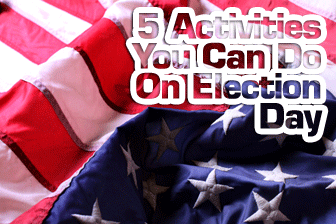It’s a Secret: 5 Activities You Can Do On Election Day


Some students are outwardly skeptical of the process, particularly when they learn that the process is largely a symbolic, academic one: that the “class president” has no official role in the class or school. (I brief them ahead of time that this process is for practice only.) So why hold a class election at all? There are a number of good outcomes. Instructors can teach the following in the course of a mock election:

We should teach the system that the students will shortly, if they don’t already, participate in. It has been shown naturalized Americans vote at higher rates than native-born ones, perhaps valuing the right to vote more. They should then be informed about the system and its benefits and flaws.
Campaigning and holding an election seem to call upon a lot of academic grammar, such as the conditional: “If you vote for me, I will clean the parking area.” The passive voice is also used: “The parking area will be cleaned.”
Students are called upon to develop their sense of audience and use persuasion as they campaign. How can they get other students to vote for them or their candidate? What can they say to get elected? This involves audience awareness: what do the voters want? A clean parking lot? More parking spaces? More desks? How can they convey to their audience, other students, that they can get the job done and meet voter expectations? Identifying a campaign slogan, or short catchy phrase, e.g., “Arturo: the Go-To Man” develops both audience awareness and language use.
Do a candidate’s promises and claims seem legitimate? Depending on the climate of the class, students may be permitted to engage in a mock “smear” campaign against the other candidate: “Don’t vote for Tatyana. She was caught stealing public money.” Students then have to evaluate how legitimate these claims seem. Which candidate seems the most reliable?
Students can be encouraged to give short speeches in which they discuss their promises to voters. This might even develop into a basic debate with another candidate in which student’s take opposing sides on an issue, such as the need for childcare on campus or allowing a smoking area. The art of courteously disagreeing with someone, largely lost in contemporary American culture, can be introduced to students and the language of disagreeing while remaining respectful taught. The audience, the other students, can watch and evaluate the debate, deciding on who won and why.
Students can be allowed, at the end of the debate, to question the candidates on the issue debated. They may also, at other times in the campaign, be allowed to interview the candidates as they decide on whom to vote for. Interviewing, and deciding the right questions to ask, requires both critical thinking and language skill, especially if the instructor has set a limit on the number of questions that may be asked. Perhaps there will be a session where everyone may ask each candidate only one question, which will be written anonymously on a slip of paper and collected, and only a set number of these will be asked, based on relevance. This forces the students to think of the most pertinent questions they can.
Writing skills develop as students create campaign posters with their slogans. They can also create short biographies or curriculum vitaes/resumes that can be made up, of course, for the candidate—but the skill of writing a biography or CV transfers to real situations that require one. Students may also write letters with their future hopes to the candidates. A number of genres are employed in launching an effective campaign.
Computer skills are also developed in the campaign as students create posters with their or their candidate’s picture, resumes that may be in brochure form, and emails to their “voters,” their classmates, about the campaign and its progress.
It is, of course, important that the campaign not take over the whole class. The first step is setting a time limit on the campaign: it might be a couple of days or a week or two, depending on your class. The campaign may only go on for a day or two and focus on the use of the conditional for making promises. Or it may extend into a longer time and incorporate more of the exercises discussed. However, setting a time limit gets students to budget their time effectively while practicing their English skills. In addition, there is a concern, particularly with a “campaign” that has gone on for some time, for students to take it a little too seriously, and some discourtesy might spring up among students. Usually all that is needed is reminding students of the importance of remaining respectful of each other, an important part of the democratic process and the ability of dissenting parties to coexist.
Election Day is here! Have students cast their votes on slips of paper, count them up, and announce the winner. Assure the students we are all “winners” in the peaceful election of our leader and celebrate with a small potluck as desired!
But by focusing on this process, rather than the results (who “wins” and “loses”), the best of democracy—egalitarianism, respect, and persuasion—is taught.